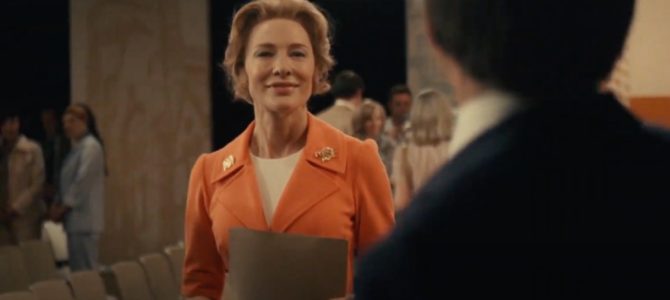
“Mrs. America” promotes a number of outright falsehoods about Phyllis Schlafly, according to the late activist’s biographer. In a Monday interview with The Federalist, Donald Critchlow, the Katzin Family Professor at Arizona State University, described the show’s depiction of Schlafly as “deplorable.”
In 2005, Critchlow authored the biography “Phyllis Schlafly and Grassroots Conservatism” for Princeton University Press. Critchlow, who’s set to release “In Defense of Populism: Social Protest and Democratic Change” this fall, helped fact check a list of claims made in “Mrs. America,” the new six-episode series from FX and Hulu purporting to chronicle the fight over the Equal Rights Amendment.
From implications of racism to marriage troubles, the show’s distortions, you’ll notice, are all in the service of creating a more negative version of Schlafly. (That’s how Schlafly’s daughter anticipated “Mrs. America” would depict her mother in a Federalist Radio Hour podcast last month.)
Why? The left, according to Critchlow, “can’t understand that people will be motivated by beliefs, and that they can have warm personalities and they aren’t filled with hatred and racism and anti-Semitism and everything else, every other kind of bigotry. They just have a hard time understanding people like Phyllis Schlafly, a woman who was devoted to her country and to the conservative cause and to founding principles, and devoted to her family.”
By the time I spoke with Critchlow on Monday, three of the show’s six episodes had aired. I ran through a list of scenes and recurring themes to get Critchlow’s assessment of their veracity. There are “two problems with the with the show,” he told me. “First of all, the mischaracterization of Phyllis Schlafly’s family life and marital relations. The second problem is that it really doesn’t capture at all why Phyllis Schlafly was a hero to many conservative women, nor does it try to explain conservative women reacting against ERA.”
From out-of-character fictionalizations to blatant historical revisionism, Critchlow, who was not contacted by the show to provide historical guidance, broke down the truth, or lack thereof, behind many of “Mrs. America’s” assertions. There are some minor falsehoods, and some major ones, but even the small inconsistencies demonstrate the show’s lack of interest in honoring the real history of Schlafly and her successful quest to defeat the ERA.
Modeling in a Bikini
The show’s first scene finds Schlafly modeling a patriotic Marshall Fields bikini on stage at a political fundraiser.
Critchlow: “I looked through the photo album, a family photo album and I actually never saw Phyllis in a bathing suit, but if she had one it wasn’t going to be a bikini, I can guarantee you that. I mean, Phyllis never even wore anything that was a low-cut dress.”
Her Marriage
The show injects tension over Schlafly’s professional ambitions into her marriage, depicting exasperation from her husband, Fred, who also insists in one memorable scene upon having sex despite his wife’s exhaustion.
Critchlow: “Phyllis Schlafly had a very, very, very happy marriage. It was one of great respect between her husband who was 12 years older. So the scene where she comes home and he insists upon marital relations is totally, totally absurd.”
“Both of them were extremely devout Catholics. He had immense, immense respect for her intellectually and as a person. And Phyllis Schlafly was a kind of person that you would respect. That was that was her bearing and persona both in public and in her relationships.”
“And I know from looking at Fred Schlafly’s personal papers that he had immense respect for her. I found a letter that he wrote at one point profusely apologizing to her for having raised his voice slightly at an airport over an issue, and he said it would never happen again, ‘I’ve never raised my voice at all in our relations.’ It was one of a partnership, not one of a domineering male patriarchal husband.”
“Fred really worshipped Phyllis and treated her, if I can use this word, like a princess.”
Personal Experiences with Sexism
When Schlafly is the only woman at a meeting in Barry Goldwater’s Senate office, she’s asked by an aide to take notes. She complies, but is clearly insulted by the request.
Critchlow: “A very prominent Republican senator had made a pass at her, Phyllis told me about. This was in the daytime, by the way, she thought he was drinking. He had come to visit her with another Republican at her house in Alton and Phyllis was so insulted by this, he was a conservative Republican. Phyllis had never forgotten that.”
“She wouldn’t have used these words, but she thought a lot of the men in the Republican Party who were supporting [the feminist constitutional Equal Rights Amendment] were just demeaning grassroots women, that they treated them like they didn’t know what they were doing.”
“To make her this cowering woman is absurd. I mean, she took on all of the men in the Republican establishment, including the president of United States, Gerald Ford, at that point. All of the major Republicans in the party were in favor of ERA. She took on those male figures.”
Her Relationship with Eleanor Schlafly
Schlafly’s sister-in-law Eleanor is portrayed as increasingly disillusioned with Phyllis’s activism.
Critchlow: “The depiction of the sister-in-law Eleanor Schlafly was really just downright despicable. Eleanor Schlafly had her own very active social life in St. Louis, she lived in Ladue. The idea that is expressed in the episode that she wanted to marry a divorced Catholic to see if he was eligible was—if you knew the Schlaflys or Eleanor, whom I knew quite well—really laughable. That was really a travesty how they depicted Eleanor Schlafly.”
Tolerance for Racism in STOP ERA
A scene at a STOP ERA meeting shows the leader of a Southern chapter attacking “commie radical lesbians” and “uppity Negroes,” proceeding to depict Schlafly’s efforts to keep the woman and her allies involved in the organization because they’re effective organizers.
Critchlow: “STOP ERA reached out specifically to the black community and there were busloads in Houston of black church members attending the STOP ERA conference. So there was a deliberate tactic of reaching out to black churches in particular. Similarly with the Jewish community — Phyllis Schlafly is often accused of being antisemitic, but she in the 1950s had received the award from the Jewish Christian Fellowship Committee in St. Louis.”
“In the South, in some chapters, there were women who were involved in the John Birch Society*, and there were a few, a small minority of women who have been involved in activities against desegregation. But this was a clear, clear minority. So I think charges of racism are completely unfounded.”
“Phyllis Schlafly, one of the attacks on her, was that she was working with the KKK. What happened was that the KKK, which is many organizations, one chapter in Illinois came out against ERA and claimed they were working with Phyllis Schlafly, and Phyllis Schlafly repudiated the KKK.”
“Phyllis Schlafly’s files are immense, with great correspondence between state organizers, state activists and Phyllis Schlafly and I did not find a instance of people raising racial issues. Indeed, I found a lot of discussion about reaching out to black churches. So I didn’t find a record of that. That’s not to say that some people, some of the activists, and I think some of the activists might have had racial feelings and that they opposed desegregation earlier, but not at that point.”
“There’s no record of [Schlafly tolerating racism.] In fact, Phyllis Schlafly actively worked for Richard Nixon in the ’68 campaign and her role in that campaign was trying to persuade voters who might go for Wallace to vote Richard Nixon. The race issue in the ’68 campaign, in the Wallace third-party run was important, and Phyllis Schlafly stood on the side of Richard Nixon.”
Her Relationship with the Family Housekeeper
The show implies towards the end of Episode 3 that Schlafly lack of self-awareness insulted her African-American housekeeper
Critchlow: “They did have a black housekeeper that was really part of the family. After Fred had died and Phyllis had moved from Alton to St. Louis, she continued to work in the home. I think she was an important figure in the house. I got to know her, I spoke to her just individually. She was quite forthcoming, and she had great respect for Phyllis Schlafly.”
Doomsday Prepping
The final scene on Episode 3 follows Schlafly into the basement of her home, which is stocked with gas masks and canned goods.
Critchlow: “I never found any evidence they were expecting a nuclear attack… I didn’t get any sense that she was a prepper. She was worried about the Soviet arms buildup. I don’t think she was worried about a direct attack at that point from the Soviet Union, so that seems a little absurd to me.”
Overall, Critchlow, who says he disagreed with certain views of Schlaflys but had a great relationship with the activist, remarked “it was really deplorable, quite frankly, how they depicted Phyllis Schlafly.”
“It wasn’t just her, but the people who were involved in her campaign, were depicted as either opportunists, or fools, or just completely misguided,” he added.
“Phyllis,” whom Critchlow described as “extremely warm” in intimate social settings, “could be very abrupt,” he said. “She could be quite charming, she had a really funny sense of humor, she was quite gracious.”
“Mrs. America” benefits from beautiful directing and some genuinely award-worthy performances (Rose Byrne). But the show obviously contorted Schlafly to fit a narrative, peddling egregious factual inaccuracies that undermine the historical record of her character. That does a disservice to viewers, and to our shared understanding of the past. As Critchlow’s insights demonstrated, the truth is more interesting than fiction anyway.
*As far as reports that Schlafly was herself a Bircher, Critchlow said, “I found no record of Phyllis Schlafly being a member of the John Birch Society,” noting that the society “openly attacked” Schlafly over her books on the Soviet arms buildup.
UPDATE 4/23/11:40 a.m.: After The Federalist’s interview with Critchlow, The Daily Beast published a report on documents from Schlafly and John Birch Society founder Robert Welch. One is a letter Schlafly sent in 1959 that said, “The John Birch Society is doing a (sic) wonderful work, and my husband and I both joined promptly after the Chicago meeting.” Per the Beast’s report, in a 1964 letter, Welch claimed Schlafly resigned from the group upon release of her book “A Choice Not an Echo” in order to avoid damaging the Goldwater cause.
If Schlafly joined after a meeting in 1959, as she herself indicated, Welch’s claims are the most significant of any evidence that exists of the high-profile activist’s continued involvement. As the Beast story notes, William F. Buckley once described Welch as “a man disconnected from reality.”
Before the Beast story published, Critchlow told The Federalist “there were members of the John Birch Society involved in STOP ERA, but that wasn’t a significant group.”
“Phyllis Schlafly and her husband may have attended one of the early seminars of Welch, like when he was organizing. But I do know they couldn’t stand Robert Welch, or Phyllis Schlafly couldn’t,” he added.
This is all important context to the story of a woman who changed the course of history.









